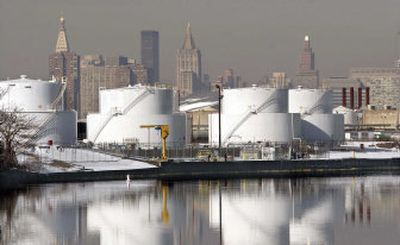Brooklyn still battles oily legacy

NEW YORK – Big Oil left most of the Brooklyn waterfront decades ago, but the industry’s legacy still bubbles to the surface.
Beneath the industrial yards and town houses of Brooklyn’s Greenpoint section lies a vast underground oil slick that at one time covered an area as big as 41 football fields and contained more petroleum than the Exxon Valdez spilled off the Alaskan coast.
The stuff oozes into a concrete-lined canal known as Newtown Creek, and some of it makes its way into the East River, leaving an oily sheen. Also, residents complain of an oily smell in their basements after heavy rains.
Refineries left the stuff behind during more than a century along the waterfront. Details of how so much oil got in the ground are something of a mystery, but Exxon Mobil accepted responsibility for much of the damage in 1990 and has been pumping out the oil since.
The cleanup, though, has been painfully slow. More than half of the 17-million-gallon spill still is thought to be in the ground. A number of Greenpoint families say their patience has run out, and more than 20 people sued in December, claiming the oil is releasing foul-smelling fumes that could be toxic or flammable.
Soil tests conducted last summer by the environmental group Riverkeeper suggested the spill might be emitting benzene gas, which can cause leukemia, and methane, which can explode in a confined space.
The tests were inconclusive, but the results still struck fear among residents. They were incensed even more by a state Department of Environmental Conservation estimate that the mop-up would take 20 more years.
“Twenty years! Are they kidding?” said one plaintiff, Robert McErlean, 58. “If they wanted to come in and drill for oil for profit, you know they’d have that oil out in 20 days.”
State health officials took issue with Riverkeeper’s findings. “All preliminary data and test samples collected near the spill site indicated that there was no immediate public health concern,” said Health Department spokesman Jeffrey Hammond.
Most of the oil is 10 feet to 40 feet underground. Brooklyn does not use wells for drinking water. Cancer rates in Greenpoint are lower than elsewhere in New York City, according to state data, and Exxon Mobil spokesman Brian Dunphy said studies have indicated that no vapors are getting into homes.
But those assurances are unlikely to end the legal battle.
The families are being represented by a California law firm that has brought in celebrity activist Erin Brockovich to recruit more plaintiffs. They are seeking unspecified damages from Exxon Mobil, Chevron and BP.
In a second lawsuit, Riverkeeper and Brooklyn’s top politicians are seeking fines of $32,500 per day from Exxon Mobil for every new oil discharge into the canal, plus fines of $27,500 for every discharge before 2004. The lawsuit is aimed at pressuring the company into adopting a more efficient way of extracting the oil.
“We know there are technologies out there that are a hell of a lot more aggressive,” said Riverkeeper investigator Basil Seggos.
The oil companies say the cleanup has been accelerated in the past few years and much less oil is leaking into the canal.
Some 40 refineries once were clustered in Greenpoint, so the oil companies disagree over who is responsible for what.
The first of Greenpoint’s refineries was opened in 1867. Much of the oil probably leaked over many decades at a time when industry was held to lower environmental and operating standards, Exxon Mobil’s Dunphy said. Some have blamed much of the leakage on a 1950 explosion caused by fuel seeping into Greenpoint’s sewers.
The scope of the plume was not discovered until 1978 when the U.S. Coast Guard noticed oil. By then, most oil company operations in the neighborhood had been closed down.
McErlean, whose grandfather was a refinery worker, said only public pressure will keep the companies from walking away entirely.
“The more squeaks in the wheel, the more it is going to get oiled,” he said. “Not that we want any more oil down here.”